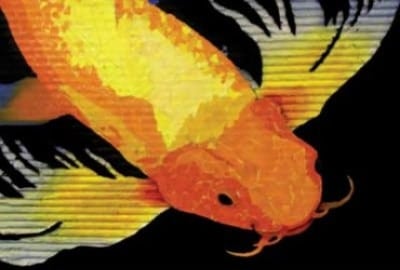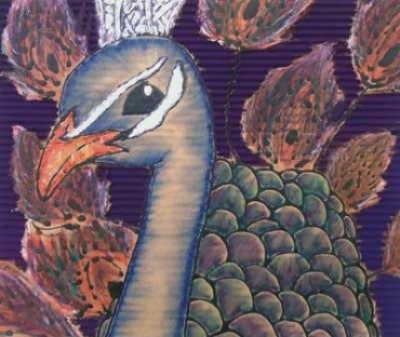Don’t throw out the boxes you receive your art supplies in—save that cardboard and recycle it into an exciting project. It’s not only a fun (and cheap) material for backing artwork and making 3-D projects, but cardboard is the perfect surface for this mixed-media art project.
This is a favorite of many of my Art I art students. It’s also a favorite of mine because it encompasses a variety of media and techniques, and teaches/reinforces the elements and principles of design. I do a short lesson on the history of collage and the students view and discuss the works of Kurt Schwitters, Picasso, Braque and Matisse. We also look at the works of several contemporary mixed-media artists such as Karen Michel.

Top: Claudia; Bottom: Hannah


TOP: Austin; BOTTOM: Jacob

Careful planning is the first step. Students have the liberty to select their subject matter from books, magazines, their photographs and the Internet. Their compositions, which are carefully rendered contour line drawings on paper, are the result of combining imagery from a variety of sources. Once the composition is finalized, cardboard is cut the same size as the drawing (usually 12″ x 18″ or larger).
Students use transfer paper to copy the compositions onto the cardboard. Next, they carefully trace over the contour line drawings with black glue. I empty white glue bottles into a large container, mix with black acrylic paint, and then pour it back into the bottles. Once all lines are traced, allow to dry overnight on a flat surface.
The next step is to use X-ACTO knives to cut away areas to reveal the corrugated “lines.” I demonstrate to students the correct way to safely and accurately cut cardboard. The raised black glue lines give a nice edge for cutting and help to unify the composition.
At this point, students may go in any of several directions using a variety of media. They may paint using tempera or acrylic; they can apply chalk or oil pastels or colored pencils directly to the cardboard surface (or apply later on the dry paint to create a variety of tonal effects).
Students must also incorporate a mosaic/collage effect somewhere in their compositions. This exercise reinforces color values as they paint a value scale of the color(s) selected. We use 9″ x 12″ drawing paper and start at the top painting very light values and gradually darken working our way down the sheet.
After drying, tear into small pieces—don’t use scissors—the white areas achieved by tearing add another design element. Overlap these pieces as they are glued down. Students may also collage old newspaper, book pages or tissue paper into their work. Experimenting with a variety of textural surfaces is strongly emphasized in this lesson.
I like to spray the entire surface with fixative when completed. This gives the work a cohesive surface. Depending on the thickness of the cardboard, it may warp a little. If so, dampen the back with a damp sponge or brush.
This lesson is ideal for teaching and/or reinforcing the elements and principles of art through the planning and execution of a mixed-media artwork. Students learn how to plan and organize for creating mixed-media art as they explore and experiment with the unique properties and potentials of materials and a variety of art media with a major focus on textural qualities.
The lesson also teaches the importance of our environment and how students as artists may incorporate discarded materials into artwork.

TOP: Cassidy BOTTOM: James

LEARNING OBJECTIVES
High-school students will …
• expand working knowledge of the vocabulary of art, and view and discuss historical and contemporary
collages and mixed-media art.
• acquire images from a variety of sources, then plan and design a composition by combining that imagery.
• express their ideas and develop skills by experimenting with a variety of media.
• develop verbal, visual, technical and creative problem-solving skills.
• interpret and evaluate their artwork and that of others.
NATIONAL ART STANDARDS
• Creating: Conceiving and developing new artistic ideas and work.
• Presenting: Interpreting and sharing artistic work.
• Responding: Understanding and evaluating how the arts convey meaning.
• Connecting: Relating artistic ideas and work with personal meaning and external context.
MATERIALS
• Drawing paper, corrugated cardboard, newspaper, book pages, wallpaper samples, tissue paper
• Tempera and acrylic paint, paintbrushes, paint trays
• Oil and chalk pastels, colored pencils
• Glue (white glue and white glue mixed with black acrylic)
• Craft knives (we used X-ACTO®)
• Spray fixative
Bill Hicks is the Visual Arts Teacher at Spring Valley High School in Columbia, South Carolina.
Reprinted with permission from Arts & Activities magazine. Visit their website: artsandactivities.com
The post Mixed Media Motivates appeared first on Schoolyard Blog | Teacher Resources | School Specialty.